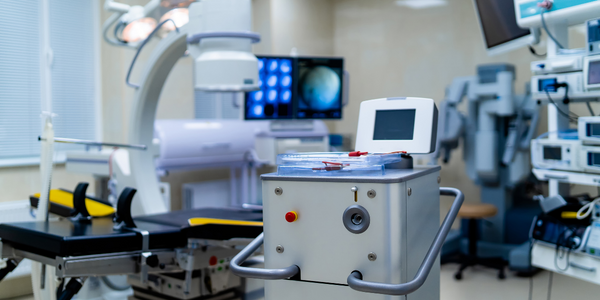Download PDF
Implementing a Next-Gen MES for Medical Device Production at a Fraction of the Cost

Technology Category
- Functional Applications - Manufacturing Execution Systems (MES)
- Platform as a Service (PaaS) - Device Management Platforms
Applicable Industries
- Electronics
- Healthcare & Hospitals
Applicable Functions
- Facility Management
- Quality Assurance
Use Cases
- Additive Manufacturing
- Manufacturing System Automation
Services
- System Integration
- Testing & Certification
The Challenge
A Medical Device Manufacturer was faced with the challenge of scaling up production for a new product introduction (NPI) within a 6-month timeline in a new greenfield assembly facility. The goal was to increase production from a few units a month built by engineers to hundreds of units a month by frontline workers. The engineering team needed to enable the frontline workers to assemble the units and record their activities at each step of the way via an eDHR for compliance purposes. The team foresaw challenges around overwhelming new staff with changing instructions and recording information. They concluded that using paper-based SOPs and history records was not a viable or efficient solution for onboarding a completely new team.
The Customer
Medical Device Company
About The Customer
The customer in this case study is a Medical Device Manufacturer. They were in the process of introducing a new product and needed to scale up production in a new greenfield assembly facility. The manufacturer was faced with the challenge of increasing production from a few units a month to hundreds of units a month within a 6-month timeline. They needed a solution that would enable frontline workers to assemble the units and record their activities at each step of the way for compliance purposes. The manufacturer decided to invest in Manufacturing 4.0 technology and implemented a validated solution using Tulip’s frontline operations platform.
The Solution
The Medical Device Manufacturer decided to go paperless by investing in Manufacturing 4.0 technology in their new greenfield facility. They implemented a validated solution using Tulip’s frontline operations platform to support all assembly operations with interactive apps. They built 90+ apps to guide and track the build process step-by-step, including test and repair workflows to capture digital history records (eDHR). The platform allowed them to track production flow at every station, visualize the full production line, and ensure they were meeting production targets. The real-time data enabled engineers to view device manufacturing progress, track WIP levels, and non-conformances, identify trends in anomalies, and rapidly find and resolve the root cause.
Operational Impact
Quantitative Benefit
Related Case Studies.

Case Study
Remote Temperature Monitoring of Perishable Goods Saves Money
RMONI was facing temperature monitoring challenges in a cold chain business. A cold chain must be established and maintained to ensure goods have been properly refrigerated during every step of the process, making temperature monitoring a critical business function. Manual registration practice can be very costly, labor intensive and prone to mistakes.

Case Study
Hospital Inventory Management
The hospital supply chain team is responsible for ensuring that the right medical supplies are readily available to clinicians when and where needed, and to do so in the most efficient manner possible. However, many of the systems and processes in use at the cancer center for supply chain management were not best suited to support these goals. Barcoding technology, a commonly used method for inventory management of medical supplies, is labor intensive, time consuming, does not provide real-time visibility into inventory levels and can be prone to error. Consequently, the lack of accurate and real-time visibility into inventory levels across multiple supply rooms in multiple hospital facilities creates additional inefficiency in the system causing over-ordering, hoarding, and wasted supplies. Other sources of waste and cost were also identified as candidates for improvement. Existing systems and processes did not provide adequate security for high-cost inventory within the hospital, which was another driver of cost. A lack of visibility into expiration dates for supplies resulted in supplies being wasted due to past expiry dates. Storage of supplies was also a key consideration given the location of the cancer center’s facilities in a dense urban setting, where space is always at a premium. In order to address the challenges outlined above, the hospital sought a solution that would provide real-time inventory information with high levels of accuracy, reduce the level of manual effort required and enable data driven decision making to ensure that the right supplies were readily available to clinicians in the right location at the right time.

Case Study
Gas Pipeline Monitoring System for Hospitals
This system integrator focuses on providing centralized gas pipeline monitoring systems for hospitals. The service they provide makes it possible for hospitals to reduce both maintenance and labor costs. Since hospitals may not have an existing network suitable for this type of system, GPRS communication provides an easy and ready-to-use solution for remote, distributed monitoring systems System Requirements - GPRS communication - Seamless connection with SCADA software - Simple, front-end control capability - Expandable I/O channels - Combine AI, DI, and DO channels

Case Study
Driving Digital Transformations for Vitro Diagnostic Medical Devices
Diagnostic devices play a vital role in helping to improve healthcare delivery. In fact, an estimated 60 percent of the world’s medical decisions are made with support from in vitrodiagnostics (IVD) solutions, such as those provided by Roche Diagnostics, an industry leader. As the demand for medical diagnostic services grows rapidly in hospitals and clinics across China, so does the market for IVD solutions. In addition, the typically high cost of these diagnostic devices means that comprehensive post-sales services are needed. Wanteed to improve three portions of thr IVD:1. Remotely monitor and manage IVD devices as fixed assets.2. Optimizing device availability with predictive maintenance.3. Recommending the best IVD solution for a customer’s needs.







